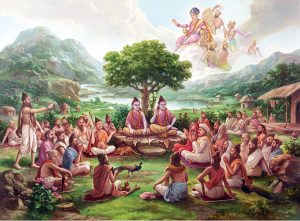
Durvasha Muni’s curse during Shri Narnarayan Dev’s sabha in Badrikashram
One day when Bhagwan Narnarayan was doing katha at Badrikashram, Himalayas. Dharma, Bhakti, Udhdhavji, etc. were present in the sabha. Later, Durvasa Rishi arrived there. But all attendees were so much into katha that no one noticed Durvasha’s arrival. Due to not receiving any attention from the attendees, he got very angry and gave a curse (shaap) to everyone present there. His command was that everyone present there goes back to earth and suffer from demonic people. In reality, Bhagwan Himself planned this drama, so He told everyone not to panic. He told Dharma and Bhakti to get ready and assured that He would take birth as their son.
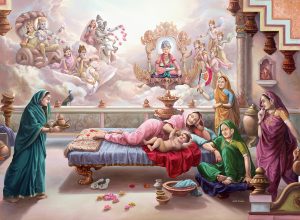
Birth of Bhagwan Shri Swaminarayan to Shri Bhaktimata in Chhapaiya
Bhagwan Swaminarayan was born on Chaitra Sud 9 1837 (or April 2, 1781) at 10:10 PM at Chhapaiya, Uttar Pradesh, India. His parents were Dharmadev and Bhaktimata. Bhagwaan had two brothers, eldest brother named Rampratapbhai and youngest named Ichharamji . On 6th day after His birth, Bhagwan was given 3 names by Markandeya Rishi – Hari, Krishna, and Harikrishna. The people of Chhapaiya gave one more name, Ghanshyam. Bhagwan learned all of the knowledge from His father by the time he was 7 years old! He learned everything from the different religious books, literature, etc. He also summarized all these books into one small book for himself, called Gutko. Bhagwan’s mom (Bhaktimata) passed away first followed by His dad (Dharmadev). As a son, Bhagwan performed very good seva for His parents until the last moment of their lives. Only after completing the responsibilities towards His parents did he decide to begin His real mission for which He took this avatar.
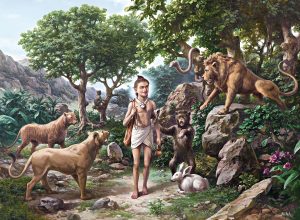
Nilkanth Varni’s Van Vicharan
At the age of 11 years, He left home and started His journey (Van-Vicharan) towards His mission. He took very minimal things with Him, like Shaligram or Lalji (for puja), a mala, a small book (Gutko), a pot for water (Kamandal) and very minimal cloth (Kopin). He started in the direction of Himalayas, where He performed tap (penance) and gave darshan to thousands of Rishis (~900,000). He continued His journey to East India and then to South India. He visited many religious places, ashrams and dangerous places. There, He re-established good religious and social values. During his Van Vicharan, he met one of His gurus named Gopal Yogi. From Gopalanand Yogi, he learned and master Ashtang Yoga. During the Van-Vicharan, he was named as Nilkanth Varni. Finally, after 7 years, 1 month, and 11 days of van-vicharan, Bhagwan arrived at Loj in Gujarat.
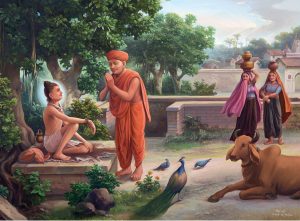
Nilkanth Varni meeting Shukhanand Swami at Loj
In Loj, there was an ashram established by Ramanand swami (who was Udhdhavji during the Krishna-avatar). Early in the morning, at the vav (a step-well) of Loj, women of the village and Shukhanand swami saw Bhagwan (Nilkanth Varni). Then, Shukhanand Swami, a follower/shishya of Ramanand Swami, invited and took Him to his Ashram. At this time, Ramanand Swami was not there (he was in Bhuj at this time), but Muktanand Swami welcomed him in the ashram. Before deciding to stay here, Bhagwan asked five questions to verify his destined place and Guru. The questions were: “What is Jiv, Ishwar, Maya, Brahma and Parabrahma ?”. Muktanand Swami (on behalf of his Guru Ramanand swami) answered all these questions to Bhagwan’s satisfaction Thus, Bhagwan concluded to stay here. Here, Bhagwan was given one more name – Sarjudas. Now he was very eager to meet Ramanand Swami. Eventually, Muktanand Swami and Bhagwan both wrote two separate letters to Ramanand Swami. Ramanand swami got excited too, because he felt that now his responsibilities will be over and Bhagwan will take over from him. He replied and said we will meet in Piplana in a few months. Finally, Bhagwan and Ramanand swami met in Piplana for the first time.
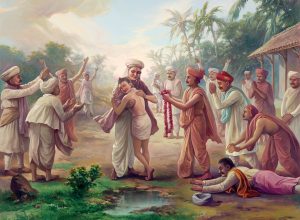
Ramanand Swami and Nilkanth Varni meeting in Piplana
Some months later, Ramanand Swami gave diksha to Bhagwan (i.e. Ramanand swami became Bhagwan’s Guru). At this time, Ramanand swami gave two new names to Bhagwan, Sahajanand Swami and Narayan Muni. Later he decided to hand over all of his establishment to Bhagwan. Finally, the grand ceremony is planned in Jetpur, and Bhagwan was made the head or Acharya of the Ramanand Swami’s Sampraday. Few months later, in Fareni, Ramanand Swami left his body and returned to Akshardham. On the 14th day after Ramanand swami’s death, Bhagwan called a grand sabha, and asked everybody to chant “SWAMINARAYAN”. Everybody went into samadhi, and they all were able to see their own preferred Ishtadev in Bhagwan (Sahajanand Swami) Himself ! This was just unique. Obviously, only God can do this. Everybody was now convinced that Sahajanand Swami is the supreme God, Purna Purushottam Narayan Himself.
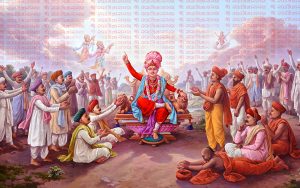
Swaminarayan Mahamantra established in Fareni
Thus, on the 14th day past Ramanand Swami’s death, Bhagwan named himself – “Swaminarayan” named the Uddhav Sampraday as the Swaminarayan Sampraday. Because Bhagwan named Himself as “Swaminarayan“, it is a very powerful name. It is not only Bhagwan’s name, but “Swaminarayan” is a “Mahamantra”.
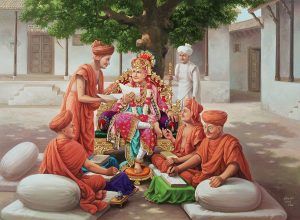
Compiling of the Vachanamrut
After this, Bhagwan Shri Swaminarayan and His Santos continued traveling around Gujarat to preach the greatness of God. During such vicharans, Bhagwan performed many Lilas (divine episodes) which strengthened the faith of devotees. Many of his teachings are compiled in the Vachanamrut. Sadguru Shri Shatanand Swami has written about Bhagwan Shri Swaminarayan’s entire life (biography) in the Shrimad Satsangi Jivan. Throughout His lifetime, Bhagwan built 6 magnificent temples.
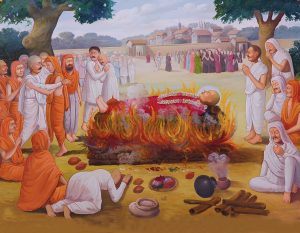
Bhagwan Shri Swaminarayan’s last rites at Laxmi Vadi, Gadhpur
When He decided that he accomplished His missions here on Earth and was time to return to His divine abode of Akshardham, He ensured that the Sampraday would continue to flourish by establishing two dioceses and a 6 pillared Sampraday (God, Acharya, Shastras, Mandir, Santo, Haribhakto). Bhagwan’s final wishes and agynas are encompassed in Desh Vibhag no Lekh. This document establishes the Guru Acharya Parampara by which Bhagwan has instructed us to follow for us to be considered true followers of the Swaminarayan Sampraday.
